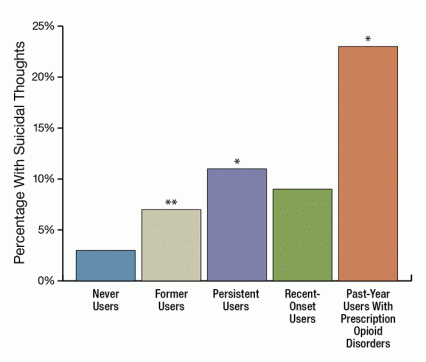People who use prescription opiates other than as ordered by a doctor are more likely to consider suicide than those who use these medications only appropriately or not at all. A recent NIDA-supported study also disclosed that the risk for suicidal thoughts remains elevated after cessation of use. The researchers suggest that both present and former users of nonprescribed opiates be monitored accordingly.
Dr. Janet Kuramoto and colleagues at the Johns Hopkins Bloomberg School of Public Health in Baltimore, Maryland, found that 15 percent of 37,933 adult respondents to the 2009 National Survey on Drug Use and Health reported having used a nonprescribed opiate at least once in their life. Among current users at the time of the survey, 11 percent who had use histories greater than 2 years (persistent), and 9 percent of those with use histories of less than 1 year (recent-onset), had thought of suicide during the past 12 months. Among former users who had not taken a nonprescribed opiate within the past year, 7 percent experienced suicidal ideation. In contrast, only 3 percent of individuals who never used a nonprescribed opiate had considered suicide (see figure below).
The severity of use was a strong determinant of suicidal ideation: 23 percent of respondents who self-reported symptoms consistent with a diagnosis of prescription opiate use disorder within 1 year before the survey had considered self-destruction. Major depressive episodes, which may increase vulnerability to nonprescribed opiate use, also increased the risk for having suicidal thoughts. Persistent and former nonprescription opiate use, but not recent-onset use, remained associated with suicidal ideation after an analysis that accounted for the impacts of depressive episodes, key demographic characteristics (e.g., gender, race, education, marital status, education, unemployment), and other drug use. The researchers surmise that several factors that were unmeasured in the study might contribute to the remaining risk, including chronic pain (which is thought to have an elevated prevalence among users of nonprescribed opiates) and nonprescribed opiate use itself.
Altogether 18 percent of current users of nonprescribed opiates who reported thinking about suicide said that they had attempted to kill themselves, compared to 11 percent of never-users and 7 percent of former users who considered suicide. Persistent use of nonprescription opioids increased the risk of moving from suicidal thoughts to attempted suicide, but this association was no longer significant after adjustment for demographic factors.
 Adult Users of Nonmedical Prescription Opioids Are More Likely Than Nonusers To Consider Suicide Both persistent† and former‡ users reported suicidal ideation at significantly higher rates than individuals who had never used a nonprescribed opioid medication. Individuals who reported past-year symptoms consistent with a diagnosis of opioid dependence were more than twice as likely as never-users to say that they had considered self-destruction. The number of individuals who converted suicidal thoughts into suicide attempts ranged from 7 to 19 percent, with no significant differences between groups.
Adult Users of Nonmedical Prescription Opioids Are More Likely Than Nonusers To Consider Suicide Both persistent† and former‡ users reported suicidal ideation at significantly higher rates than individuals who had never used a nonprescribed opioid medication. Individuals who reported past-year symptoms consistent with a diagnosis of opioid dependence were more than twice as likely as never-users to say that they had considered self-destruction. The number of individuals who converted suicidal thoughts into suicide attempts ranged from 7 to 19 percent, with no significant differences between groups.† Initiated use more than 2 years ago with continued use in the past year
‡ Initiated use more than 2 years ago, with no use in the past year
Recent-onset: Initiated use less than 2 years ago
* p <0.05
** p <0.01
This study was supported by NIH grants DA020667, AG030908-02, DA023618, and R21 DA020667.
Source:
Kuramoto, S.J., et al. Suicidal Ideation and Suicide Attempt Across Stages of Nonmedical Prescription Opioid Use and Presence of Prescription Opioid Disorders Among U.S. Adults. Journal of Studies on Alcohol and Drugs 73(2): 178-184, 2012. Abstract